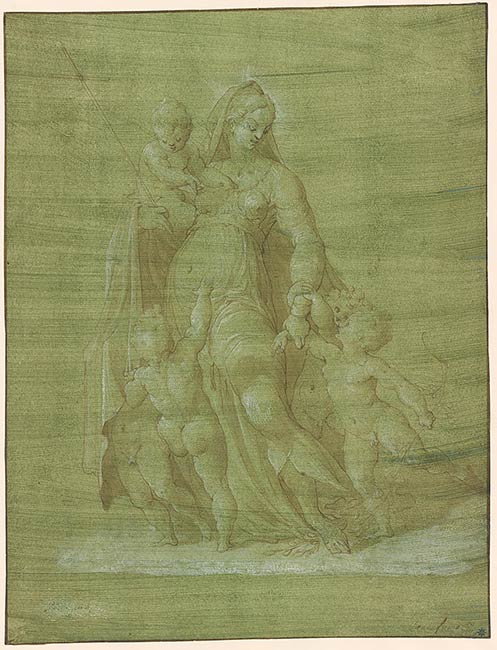
Girolamo Macchietti, who trained under Michele Tosini, began his career working with Vasari and his team of artists on the redecoration of the Palazzo Vecchio, for which Macchietti apparently designed tapestries. After six years with Vasari, Macchietti continued his studies in Rome for two years, before returning to Florence to join the Accademia del Disegno and to establish himself as an independent master. While Macchietti continued working on the decorations of the Palazzo Vecchio, creating paintings for the Studiolo of Francesco I, he also contributed to other significant Florentine sites, producing altarpieces for the churches of San Lorenzo (1568), Santa Maria Novella (1573) and Santa Croce (1575). The artist’s early career is marked by the strong influence of Mannerists like Vasari and Parmigianino, although he gradually developed a more restrained style, potentially as a result of viewing contemporary works on another trip to Rome or under the influence of the Counter-Reformation in Florence.
This sheet is thought to have been made towards the height of the artist’s career and is perhaps inspired by Andrea del Sarto’s 1513 fresco of Charity in the Chiostro dello Scalzo in Florence, which Macchietti may have seen and admired as a student. The elegant female figure of Charity reflects Macchietti’s affection for Parmigianino’s style. In her monographic study of Macchietti, Marta Privitera records that the attribution of the present sheet was first made by Catherine Monbeig Goguel.1 Privitera connects the Morgan study to a group of drawings in the same technique, which she dates to the 1560s.
Footnotes:
- Privitera 1996, 1: 107, no. 17.
Macchietti, who trained under Michele Tosini, began his career working with Vasari and his team of artists on the redecoration of the Palazzo Vecchio, for which he apparently designed tapestries. After six years with Vasari, the artist continued his studies in Rome for two years, returning to Florence thereafter to join the Accademia del Disegno and to establish himself as an independent master. While Macchietti continued working on the decorations of the Palazzo Vecchio, creating paintings for the Studiolo of Francesco I, he also contributed to other significant Florentine sites, producing altarpieces for the churches of San Lorenzo (1568), Santa Maria Novella (1573) and Santa Croce (1575). The artist's early career is marked by the strong influence of Mannerists like Vasari and Parmigianino, although he gradually developed a more restrained style, potentially as a result of viewing contemporary works on another trip to Rome or under the influence of the Counter-Reformation in Florence.
This sheet is the first by Macchietti to enter the collection. It is thought to have been made towards the height of the artist's career and is perhaps inspired by Andrea del Sarto's 1513 fresco of Charity in the Chiostro dello Scalzo in Florence, which Macchietti may have seen and admired as a student. The elegant female figure of Charity reflects Macchietti's affection for Parmigianino's style.
Inscribed on recto in brown ink at lower right, "Beccafumo."; faintly inscribed at lower left, "Passignano"; stamped at lower right with an eight-pointed star. Inscribed on verso in brown ink in an old hand at upper left, "Stradino" (crossed out) "beccafumi"; on lower right margin, in graphite, "37".
Watermark: Letter "P".
Canovas, Manuel, 1935- former owner.
Selected references: Privitera 1996, 1: 107, no.17.
Privitera, Marta, Girolamo Macchietti: un pittore dello Studiolo di Francesco 1, 1996, no. 17.
Colnaghi, New York and London, An Exhibition of Master Drawings, exh. cat., 1996, no. 10, repr. in color.

